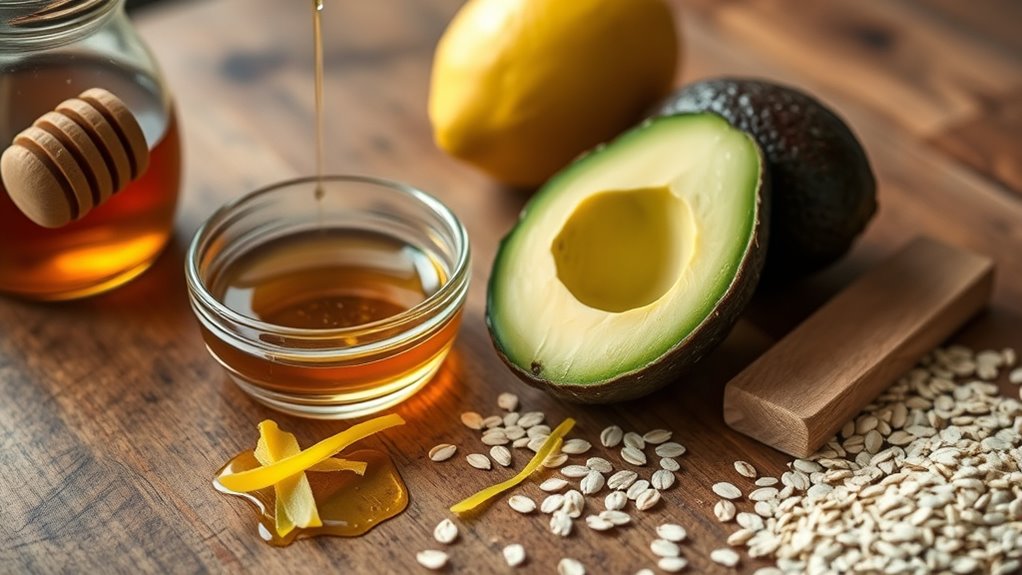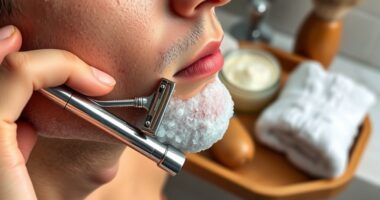To achieve glowing skin with DIY facial masks, use five simple kitchen ingredients: honey, yogurt, avocado, lemon, and clay. Honey moisturizes and soothes, while yogurt gently exfoliates and balances your skin. Avocado hydrates and reduces inflammation, lemon brightens and even tones, and clay cleanses pores by absorbing excess oil. Combining these ingredients offers a natural, customizable skincare routine. Keep exploring to discover how to blend and apply these remedies for the best results.
Key Takeaways
- Honey and yogurt combined soothe, hydrate, and brighten skin with antibacterial and exfoliating benefits.
- Avocado provides deep hydration and reduces inflammation, ideal for dry or sensitive skin.
- Citrus fruits like lemon or orange boost radiance with vitamin C for a natural glow.
- Clay masks with apple cider vinegar absorb excess oil and purify pores effectively.
- Customize masks with these ingredients based on your skin type for safe, natural skincare.

If you’re looking for a simple way to refresh your skin at home, DIY facial masks are an excellent choice. Using kitchen ingredients, you can create effective masks that nourish, hydrate, and brighten your complexion without the need for expensive products. These natural remedies are easy to incorporate into your skincare routines, giving you a fresh glow with minimal effort.
One of the biggest advantages of homemade masks is that you know exactly what’s going into them. You can avoid synthetic chemicals and preservatives found in many store-bought products. Plus, the ingredients are often readily available in your kitchen, making it convenient and cost-effective to experiment with different recipes. For example, honey is a popular natural remedy because of its antibacterial and moisturizing properties. Applying a thin layer of raw honey to your face can help soothe irritation and provide a gentle, natural glow.
Homemade masks let you control ingredients, avoiding synthetic chemicals while using easily available kitchen items for effective skincare.
Another common ingredient in DIY masks is yogurt. It contains lactic acid, which gently exfoliates dead skin cells, revealing a brighter complexion. When combined with honey or oats, yogurt can help balance your skin’s pH and improve texture. If you’re aiming for a calming mask, mashed avocado works wonders. Rich in healthy fats and antioxidants, avocado hydrates dry skin and reduces inflammation, making it ideal for sensitive or irritated skin.
Citrus fruits like lemon or orange juice are often used for their high vitamin C content, which helps brighten dull skin and evens out skin tone. However, it’s important to use citrus sparingly and be cautious if you have sensitive skin, as lemon juice can cause irritation or photosensitivity. Mixing lemon juice with honey and yogurt can create a brightening face mask that also provides hydration.
For those with oily or acne-prone skin, masks made from clay or bentonite can help absorb excess oil and impurities. You can mix these with apple cider vinegar or water to create a paste that cleanses your pores thoroughly. Incorporating these ingredients into your skincare routines regularly can help manage oil production and prevent breakouts, leaving your skin feeling fresh and clean.
Additionally, home improvement principles such as creating designated zones or using multi-functional ingredients can inspire you to design a skincare routine that fits your space and lifestyle. Incorporating natural remedies into your skincare routines through DIY facial masks is not only simple but also customizable. You can adjust ingredients based on your skin type and needs, making your skincare routine more personal and effective. Regularly using these kitchen-based masks can boost your skin’s health, enhance your natural glow, and provide a satisfying, self-care experience—all from the comfort of your home.
Frequently Asked Questions
Are DIY Masks Suitable for Sensitive Skin Types?
You might wonder if DIY masks suit sensitive skin. It’s crucial to take into account natural ingredient safety, as some kitchen ingredients can cause irritation. Always perform skin sensitivity testing before applying any mask to your face. If your skin reacts negatively, stop using it. For sensitive skin, stick to gentle, soothing ingredients like honey or aloe vera, and avoid harsh or acidic items. This way, you can enjoy the benefits safely.
How Often Should I Use Homemade Facial Masks?
Think of your skin as a delicate garden that needs just the right watering. For homemade facial masks, the frequency of use depends on your skin type considerations; generally, 1-3 times a week is ideal. Sensitive skin may need less, while oily skin can benefit from more frequent treatments. Listen to your skin’s signals and adjust accordingly, nurturing its natural glow without overwhelming it.
Can Kitchen Ingredients Cause Allergic Reactions?
You might wonder if kitchen ingredients can cause allergic reactions. Yes, they can, especially if you have allergy symptoms or sensitive skin. Always check ingredient safety before applying anything to your face. Perform a patch test first to see how your skin reacts, and consult with a dermatologist if you’re unsure. Being cautious helps prevent allergic reactions and keeps your skin glowing and healthy.
Do DIY Masks Replace Professional Skincare Treatments?
DIY masks can’t fully substitute professional skincare treatments because they often lack the precision and strength needed for certain skin issues. While DIY masks are budget-friendly and convenient, they may not match the professional effectiveness of dermatologist-recommended procedures. Consider using DIY masks as supplementary care, but for serious concerns, investing in professional treatments ensures better results and tailored solutions, making it a smarter choice despite the higher cost.
How Long Should I Leave the Mask On?
Your skin’s patience isn’t endless, so don’t leave your mask on forever! Typically, you should keep it on for about 10-15 minutes, allowing the ingredients to work their magic. Pay attention to your skin’s reaction—if you feel any irritation or burning, rinse it off immediately. The right application duration maximizes benefits without risking overexposure. Remember, less is often more when it comes to DIY skincare!
Conclusion
Now that you know these simple kitchen ingredients can boost your glow, why not give them a try? DIY facial masks are easy, affordable, and fun to make—plus, they’re tailored to your skin’s needs. Imagine the satisfaction of pampering yourself with natural, homemade remedies. So, are you ready to transform your skincare routine and reveal radiant, healthier skin that’s just a mask away? Go ahead, get mixing and enjoy your glowing new look!









